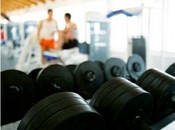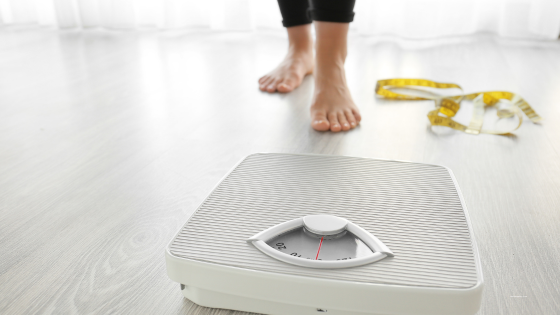 Congratulations! After repeatedly putting off enrolling at your local health club, you’ve finally decided to begin a fitness program. But wait — you’re not sure where to start. Fitness centers and health clubs can be a little overwhelming to say the least. All the strength equipment, different types of cardiovascular machines, and classes to pick from can make it challenging to decide how to get the most out of your time in the gym in order to achieve the results you want. However, don’t worry because it’s not as intimidating and difficult as it might seem. Take some time to pray about your fitness goals. Then consider what exercises and equipment are best for your needs.
Congratulations! After repeatedly putting off enrolling at your local health club, you’ve finally decided to begin a fitness program. But wait — you’re not sure where to start. Fitness centers and health clubs can be a little overwhelming to say the least. All the strength equipment, different types of cardiovascular machines, and classes to pick from can make it challenging to decide how to get the most out of your time in the gym in order to achieve the results you want. However, don’t worry because it’s not as intimidating and difficult as it might seem. Take some time to pray about your fitness goals. Then consider what exercises and equipment are best for your needs.
Orientation and Initial Personal Training Sessions
Any decent health club or fitness center should have some qualified personnel on their staff to at least provide an orientation for newcomers enrolling at their facility. This should be a free service, or something that is offered for a modest fee. The orientation or introductory workouts can be conducted one-on-one, or in a small group setting. You can expect to get a tour of the fitness area, and an introduction to most of the basic strength training and cardiovascular machines in the facility. A better strategy is to hire the services of a certified, qualified personal trainer. This process is much more involved, as the trainer will conduct an initial fitness evaluation to assess your current physical fitness status, along with prescribing your first workout program. The trainer will usually record the exercises on a workout log, and then take you through demonstrating how to perform each exercise safely and effectively. I’m a proponent for hiring a certified personal trainer for at least three one-on-one sessions to get you going in the right direction. A session with a qualified, certified personal trainer can run you between $50-$75, but it’s well worth the investment. A good trainer can also save you a considerable amount of time that you risk losing if you try to go at it on your own from the start.
TIP: Find a certified personal trainer that will offer a Christian faith focus. This trainer can help bring additional perspective to your goals, focus, approach, attitude and overall experience.
The Five Components of Physical Fitness
Regardless of whether or not your exercise goals include slimming down and losing weight or increasing your muscular size and strength, any good exercise program should include a variety of exercises that incorporate all five components of complete physical fitness. The five components of physical fitness are muscular strength, muscular endurance, body composition, flexibility and cardio respiratory endurance.
Muscular Strength
Muscular strength can be defined as the greatest amount of maximum force a muscle can exert in a single effort. A common measuring stick often used in determining muscular strength is the one-rep Olympic bench press lift. (Keep in mind that any one-rep maximum lifts should only be done under the close supervision of a qualified personal trainer or strength coach, and always make sure to have at least one spotter.) You must always make sure to thoroughly warm up by performing some higher rep sets, with a lighter weight load prior to attempting your one-rep max lift. The one-rep bench press is an advanced test for muscular strength, and may not be recommended for most novice and beginners. While the one-rep bench press is often used to determine upper body muscular strength, the one-rep leg press or squat is a good measure for lower body muscular strength. All the same safety guidelines and procedures outlined for the one-rep maximum bench press lift should also be applied for the squat or leg press. Muscular strength is very important for athletes such as football players and weightlifters, but arguably the least important component of physical fitness for the majority of people engaging in an exercise program.
Muscular Endurance
Muscular endurance is the ability of a muscle or group of muscles to perform repeated movements for an extended period of time with a sub-maximal force. A good test to use for muscular endurance is the amount of push-ups a person can do until failure. Other tests for one’s muscular endurance can be performed on any number of different selectorized weight training machines. Once the user is able to determine their one-rep max on a machine, the trainer will take approximately 60% of this weight and count how many repetitions the user can perform until fatigue sets in. Common exercises for improving muscular endurance include bench presses, shoulder presses, biceps curls, triceps pushdowns, dips and abdominal crunches for the upper body. Exercises often noted with muscular endurance for the lower body include leg extensions, leg curls, calf raises and leg presses. All of these exercises can be performed on machines, which tend to be a little safer, while many can also be done using free weights.
Much has been written about the advantages and benefits of using free weights over machines and vice versa, for strength training exercises. Unless you have some specific medical conditions that prohibit you from exercising with free weights, or are a brand new beginner to a weight resistance routine, be sure your workout involves a combination of strength training exercises with both free weights and machines.
Some of the benefits of using free weights, especially dumbbells, include a greater range of motion, the ability to incorporate more stabilizer muscles into your exercise, and insuring that each side works evenly in lifting the same amount of weight. For example, if you’re performing an incline dumbbell fly, and you have a 15 lb. dumbbell in each hand, there’s no way that your dominant arm can lift more weight than your weaker arm. Many times our stronger side will end up overcompensating for our weaker side; thereby creating an uneven workload when we perform strength-training exercises using a machine.
There are several benefits of performing weight resistance exercises using a machine. You get better isolation and contraction of the muscle group being trained. The muscle can be exercised with continuous tension. Machines are usually considered safer because the workload is easier to control and balance.
Incorporating both machines and free weights into your strength training routine provides for a greater variety of exercises to perform, keeps your routine fresh and interesting, and ensures that your muscles don’t adapt to your exercise regimen too quickly. This will keep your progress moving along.
Body Composition
Body composition is the percentage of body fat a person has in comparison to their total body mass. The medical community often uses body fat percentage to help in determining one’s overall health rating. According to the National Institute of Health, healthy body fat percentages for males fall between 13% – 17%, and 20% – 25% for women. Men and women who have a body fat percentage greater than 25% and 32% respectively are considered to be obese. Obesity, particularly childhood obesity, is an epidemic in the United States. People who have body fat percentages considered to be in the obese range are at a far greater risk of developing diabetes, heart disease and decreasing their life span. The best method for lowering your body fat percentage is to eat a healthy, well-balanced, low-fat diet, and exercise on a routine basis of at least four times per week.
Cardiorespiratory Endurance
If we were to prioritize the five levels of physical fitness, cardiorespiratory endurance would undoubtedly be the most important of them all. Also commonly referred to as cardiovascular fitness or aerobic fitness, the American Council on Exercise defines cardiorespiratory endurance as the health and function of the heart, lungs and circulatory system. It is related to the body’s ability to persist or sustain activity for prolonged periods of time. Cardiorespiratory endurance is the efficiency with which the body transports oxygen and nutrients to the cells, while transporting waste products from the cells.
Exercises and machines most commonly used to improve one’s cardiorespiratory endurance include walking and running, biking, and any number of other aerobic exercises including the stair climber, elliptical machine and taking an aerobics or other group exercise class. The importance of incorporating a consistent regimen of cardiovascular exercises into your regular exercise routine cannot be overstated. Strengthening the heart and lungs, and making your cardiovascular system more efficient is paramount in maintaining and improving your health, while reducing your body fat percentages. [NOTE: We will devote an entire article on cardiovascular and aerobic fitness in an upcoming issue of Faith and Fitness Magazine.] Most people should strive to work their way up to performing at least 30 minutes of cardiovascular exercise 4-5 times a week. As always, make sure you have a complete medical evaluation and physical assessment prior to beginning an exercise routine.
Flexibility
Last but not least the most often overlooked component of physical fitness is flexibility. Flexibility can be defined as the ability to move a joint through an entire, normal range of motion. Flexibility can be easily improved by incorporating a series of various stretching exercises three times per week. Incorporating regular stretching exercises into your fitness program has many benefits including: prevention of injuries, increased circulation and blood flow, preserving and improving range of motion, preparing the body for more vigorous exercise and helping relax and cool down the body after a workout.
Stretching exercises should be performed at the beginning of your exercise routine, preferably after an initial period of light aerobic exercise to elevate your heart rate, and increase your body temperature. This light “warm-up” period prepares the muscles by helping increase their elasticity, and is almost always preferred over stretching a completely “cold” muscle. Most people should concentrate on performing static stretching exercises. Static stretching is a slow, smooth stretch where you reach a holding position and maintain that position for 10 to 30 seconds. Your trainer or instructor at your local fitness center will be able to provide a series of stretching exercises to assist with improving your flexibility for all the major muscle groups. Be sure to be on the lookout for future articles that go into more detail about flexibility and stretching in Faith and Fitness Magazine.
No matter if you’re brand new to exercising, or a seasoned pro, you need to be sure that your exercise program is thorough and well-balanced by containing a variety of exercises that address all five components of complete physical fitness. Just like building a house, you must have a solid foundation upon which to build a healthier body, mind and soul.
 Rob Killen is a 20-year veteran in the health and fitness industry. He received his Bachelor’s in Education from Wayland Baptist University in Texas, and his Master’s in Public Administration and Nonprofit Management from George Mason University in Fairfax, VA. Rob served in the U.S. Air Force from 1988–1992, where he was awarded The Air Force Achievement Medal for helping make the Reese Air Force Base Athletic Program in Lubbock, Texas one of the most effective and successful in the Air Force. He regularly consults with health clubs. Rob is a Certified Personal Trainer with the American Council on Exercise, and a former competitive bodybuilder. He attends Williamsburg Community Chapel, an interdenominational faith based church in Williamsburg, Virginia.
Rob Killen is a 20-year veteran in the health and fitness industry. He received his Bachelor’s in Education from Wayland Baptist University in Texas, and his Master’s in Public Administration and Nonprofit Management from George Mason University in Fairfax, VA. Rob served in the U.S. Air Force from 1988–1992, where he was awarded The Air Force Achievement Medal for helping make the Reese Air Force Base Athletic Program in Lubbock, Texas one of the most effective and successful in the Air Force. He regularly consults with health clubs. Rob is a Certified Personal Trainer with the American Council on Exercise, and a former competitive bodybuilder. He attends Williamsburg Community Chapel, an interdenominational faith based church in Williamsburg, Virginia.








